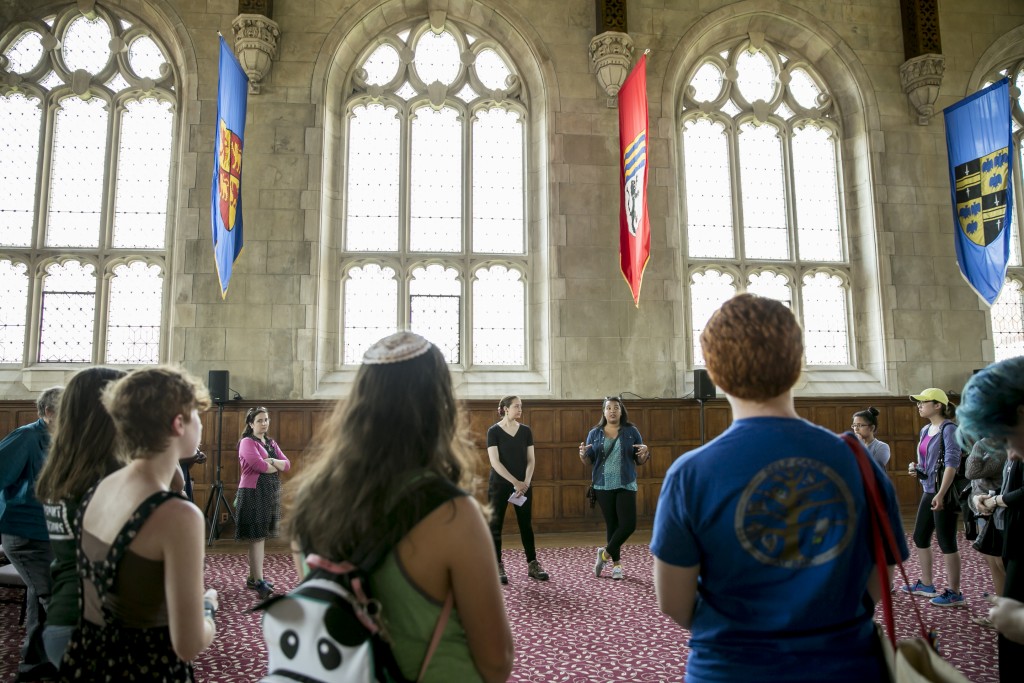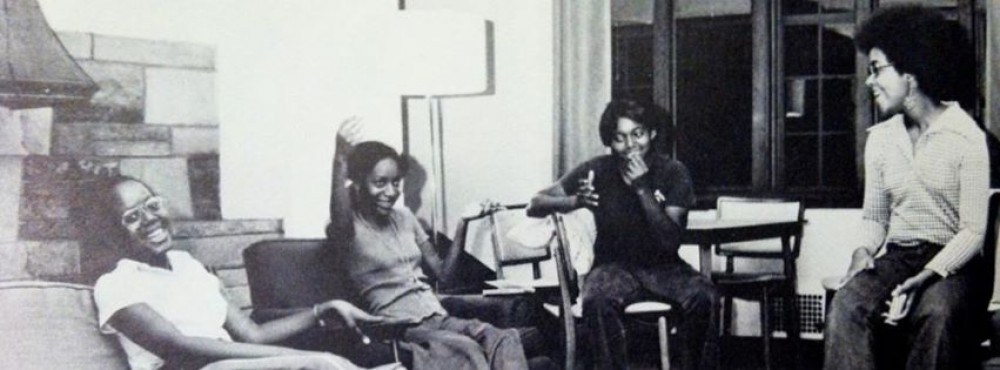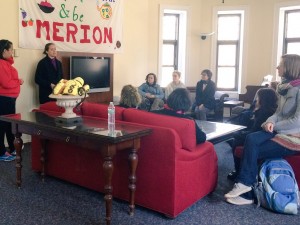by Emma Kioko
Now that our Black at Bryn Mawr research project is finishing for this semester, I wanted to take a moment to reflect on my experiences leading six public walking tours in April and May and a handful of private tours. (Grace and I were even given the opportunity to present an abridged version of the tour to President Cassidy and Provost Osirim!)

Emma Kioko ’15 and Grace Pusey ’15 introduce the Black at Bryn Mawr tour in Thomas Great Hall (May 6, 2015). Photograph courtesy of the Office of College Communications.
When I originally proposed the idea of the walking tour last summer, and then again in the Fall of 2014, I overlooked the amount of anxiety speaking and presenting in front of large groups of people usually causes me. As Grace and I researched for the tour, none of my nerves kicked in–with the amount of research we had to cover, reaching the walking tour stage of our project always seemed so far away. It wasn’t until the morning of our first tour that I started to panic. There are so many stories of black experiences on campus that our semester-long research period was unable to uncover, so many more angles of research that we were both interested in exploring. I felt a little bit unprepared. The night before the first tour, in fact, when Grace and I met to run through a quick overview of the tour, a Spanish professor stopped to tell us a story about Black student Enid Cook (Class of 1931) outraging students and the administration when she was let into Rockefeller dorm by another student. As interesting as the story was, it was just another reminder for me of just how many stories still sat undiscovered, despite how much information we had uncovered during our time in Special Collections.
On the day of the first tour, I was grateful that our fieldwork advisor, Monica Mercado, suggested holding “test run” tours. The friendly faces in Professor Linda-Susan Beard’s Black Bards class really helped me get over my nerves and the initial awkwardness of testing out the precarious boundary between presenting academic research and presenting a walking tour. One of the greatest challenges leading up to the tour, for me, was challenging myself to break out of my academic voice. While preparing for the tour, Grace and I even had to scrap a huge document that detailed everything we wanted to discuss, because when we practiced for the tour and read from the paper we had written, it came out dry and incredibly academic. Negotiating the difference between the language I would use for a paper and the language I ended up using on the walking tour was not an easy process.
The “public” tours, I discovered, were extremely unpredictable. Despite overwhelmingly positive feedback on all of our tours, some of them were harder than others. Some days our audience was very quiet, and other days we had to cut discussion short in order to stay on schedule! In particular, through my experience I have realized the incredible power and importance of asking questions. Questions made the difference between some of our good tours and some of our great tours. Questions not only allowed Grace and I to improve later iterations of the tour but also created a better atmosphere on the tours themselves. Some of the best moments on the tours for me were times when a student or a staff member would ask a question and another community member on the tour would answer. The interactions between community members on the tour would generally create a much more relaxed and engaged atmosphere, which allowed the participants on the tour to reflect even more on the spaces and information we presented. I also think that questions pushed our research even further. Some questions would allow me to make connections with information I had found over the semester in incredibly new ways.
Perhaps the best moments of the tours for me happened when Grace or I would be speaking and the face of a community member would rise in shock or intrigue. Moments where participants on the tour would so visually engage with the material we had discovered over the semester are what make the medium of a walking tour so special. In addition to presenting about Bryn Mawr’s past, I often watched students, as we finished discussing black labor, take one last look around Merion as we walked out of the hall–as if truly reconsidering what the space has meant for black bodies throughout Bryn Mawr’s history.
The walking tour was created with those moments in mind. It aims to take familiar spaces on campus and defamiliarize them in a meaningful way–a way that can create conversation and inspire members of our community to continue searching out and re-remembering black experiences at Bryn Mawr. As Grace continues this project in the summer, beyond graduation, my advice to her would be to utilize and capitalize on social media–a point we were both reminded of last week. One of our most well attended tours was actually our last. Just the night before, Bryn Mawr social media was buzzing with news that brought last Fall’s campus conversation about the Confederate flag-hanging incident back to the fore. Reminders that our project had been inspired by this incident were then posted to these same social media channels, bringing, in particular, an incredible student turnout to the tour the next day. The reason for this turnout, however, remains an example of how far Bryn Mawr still has to go. Grace’s continuation of the project during the Summer of 2015 will hopefully continue to attract new audiences and online engagement.
I hope that as Bryn Mawr continues to move forward, members of the community can continue to learn about these difficult, yet empowering, histories.


